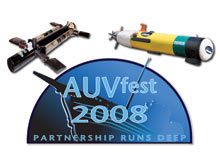
Join us for AUVfest 2008. This unique expedition demonstrates and tests the applications of autonomous underwater vehicles, or AUVs, for both the Navy and NOAA archaeological research. Click image for larger view and image credit.
AUVfest 2008: Navy Mine-hunting Robots Help NOAA Explore Sunken History
May 12 - 23, 2008
With the exciting spirit of cooperation and discovery, AUVfest 2008 is a unique opportunity to demonstrate and test the applications of autonomous underwater vehicles, or AUVs, for both mine countermeasures and archaeological research. In total, 13 AUV systems are participating in the missions, which will take place in Rhode Island’s Narragansett Bay. AUVfest 2008 is hosted by and based at the Naval Undersea Warfare Center (NUWC) in Newport, Rhode Island. The Office of Naval Research (ONR) and NOAA’s Office of Ocean Exploration and Research are sponsoring the event.
AUVs are unmanned underwater robots akin to the Exploration Rover NASA uses on Mars. As their name suggests, AUVs operate independently of humans. They use their sensors to create maps of the ocean floor, record environmental information, and sense what humans have left behind. In military applications, such as hunting for underwater mines, AUVs can literally save lives. Since World War II, more U.S. Navy ships have been damaged or lost due to mines than all other causes combined. The ONR supports and develops AUVs that can locate, classify, and neutralize underwater mines.
Perhaps unsurprisingly, the AUVs and sensors developed for mine countermeasures can be very useful to maritime archaeologists. Acoustic sonar, for instance, can scan broad areas of the ocean bottom and provide fine-detail images of objects on the sea floor. Below-bottom imaging systems can generate tomographic, or sectional, images of buried objects. As interest grows in deep-water exploration, AUVs can play an important role in discovering clues about human history. One of the goals of AUVfest 2008 is to expose maritime archaeologists to the capabilities of AUVs and sensors in finding, mapping, and protecting shipwrecks and archaeological sites.
Through this collaboration, both federal organizations will benefit. NOAA archaeologists will test existing equipment, allowing them to try AUVs in actual archaeological expeditions. Technology developers for the Navy will learn about the needs of this new set of users, driving them to create more flexible and robust systems. The fact that they will be considering scientific and military objectives will fuel them to develop new AUV innovations and applications. The Navy and NOAA hope that their partnership will run deep, sustaining and strengthening in the future.
![]() NOAA Podcast:
NOAA Podcast:
Learn what we hope to discover on this expedition with a video
or audio podcast on the mission. (Quicktime, 3 Mb.)
You can access the Ocean Explorer AUVfest 2008 News feed here:![]()
Updates & Logs
Click images or links below for detailed mission logs and updates.
 Mission Summary NOAA’s Frank Cantelas' mission summary highlights AUVfest 2008 successes. NOAA’s collaboration with the Office of Naval Research paired maritime archaeologists with AUV technologists, reflecting the expedition's theme, “Partnership Runs Deep.”
Mission Summary NOAA’s Frank Cantelas' mission summary highlights AUVfest 2008 successes. NOAA’s collaboration with the Office of Naval Research paired maritime archaeologists with AUV technologists, reflecting the expedition's theme, “Partnership Runs Deep.”
 May 19 Participants at the AUV and maritime archaeology workshop — including archaeologists, technicians, and Navy personnel — unanimously agreed that cooperation was critical for their success. Discover why!
May 19 Participants at the AUV and maritime archaeology workshop — including archaeologists, technicians, and Navy personnel — unanimously agreed that cooperation was critical for their success. Discover why!
 May 18 Many of the expedition's AUVs were developed for the Navy's mine applications, but their systems can also sense archaeological artifacts — making the Navy’s investment in technology doubly beneficial.
May 18 Many of the expedition's AUVs were developed for the Navy's mine applications, but their systems can also sense archaeological artifacts — making the Navy’s investment in technology doubly beneficial.
 May 17 Acting as the expedition safety leads, three Navy reservists provide their straightforward perspectives on the daily surprises during AUVfest.
May 17 Acting as the expedition safety leads, three Navy reservists provide their straightforward perspectives on the daily surprises during AUVfest.  May 16 During the first days of AUVfest 2008, some rough weather spelled trouble for AUV systems.
May 16 During the first days of AUVfest 2008, some rough weather spelled trouble for AUV systems.  May 15 How does an autonomous underwater vehicle (AUV) find its way — without a human operator?
May 15 How does an autonomous underwater vehicle (AUV) find its way — without a human operator?  May 14 Rhode Island, the "Ocean State," has more shipwrecks per square mile than any other state. We know of more than 2,000 ships that have sunk in its waters — and there are certainly many more.
May 14 Rhode Island, the "Ocean State," has more shipwrecks per square mile than any other state. We know of more than 2,000 ships that have sunk in its waters — and there are certainly many more.














